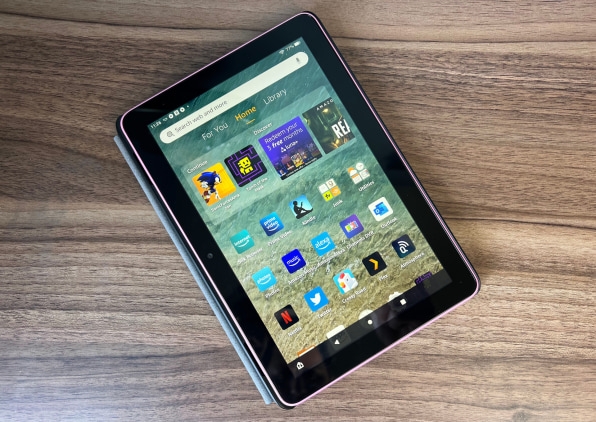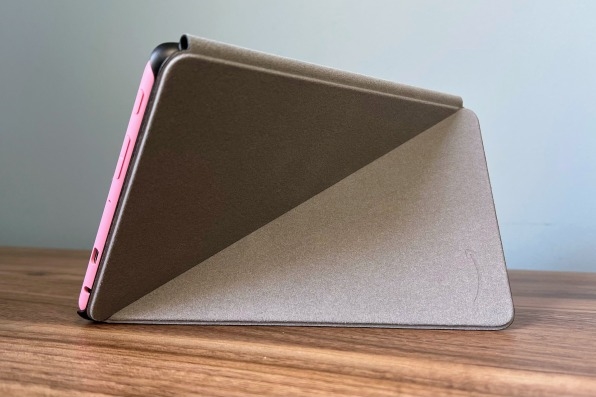Amazon’s Fire HD 8 tablet would still be better with Google
After setting up Amazon’s new Fire HD 8 tablet, I was quickly reminded of how hamstrung it is without the Google Play Store.
Sideloading Google’s app store is usually my first move when acquiring one of Amazon’s tablets. But because I received a review unit ahead of last week’s official launch, the usual steps didn’t work for the Fire HD 8.
That in turn left me with the Amazon Appstore’s far more limited selection and plenty of gaps in functionality. And it made me wonder why Amazon and Google haven’t found a way to end their long-running impasse. Shouldn’t these companies put aside their petty differences and find more ways to work together?
Going without Google Play
The Fire HD 8 is better than the 7-inch model thanks to a much roomier screen, and while it still feels a bit sluggish despite a 30% faster processor than before, Amazon’s tendency to offer deep discounts makes the value unbeatable. (The tablet currently costs $100 at full price, but half-price deals were common on previous models.)
Even as a budget tablet, though, the Fire HD 8 is only viable without the Google Play Store if your needs are fairly narrow.

It supports most streaming video apps, for instance, so you can watch Netflix, HBO Max, Disney+ and the like on its 8-inch, 720p display. Major social media apps such as Instagram, Twitter, and TikTok are available as well, and of course it’s great for reading e-books provided you’re a Kindle user (though I wish the app supported page turn animations, like it does on iOS). Amazon sells a $30 fabric cover with a triangular flap that folds back like a picture frame, making tabletop use especially convenient.
But even within the confines of media consumption, you’ll run into some limitations. On the Fire HD 8, Amazon’s Appstore is missing Apple TV+, YouTube TV, DirecTV Stream, and Fubo TV. It also lacks Apple Music and YouTube Music.
And while the Fire HD 8 isn’t a great gaming tablet due to its pokey processor, its gaming options don’t come close to those of iOS and Android. Of the top 20 free games currently on iOS, only seven are available on the Fire tablet. (I also see suspicious clones of several top free Android games, with up-front purchase prices, different developers, and zero user reviews.) Even if you find the games you want on the Fire HD 8, you won’t be able to sync your progress from a phone via iOS GameCenter or Google Play Games.

The more specific your app needs get, the more you’ll likely be disappointed. It’s missing popular meditation apps such as Calm and Headspace, and it’s without Notion and Slack on the productivity front. Logging into apps and websites will also be a pain, as Amazon’s Appstore is bereft of popular password managers such as Bitwarden and 1Password.
On top of all that, Google’s own apps are unavailable on Fire tablets. In many cases, Amazon has created its own alternatives, including an unofficial YouTube viewer and apps for mail, calendar, and web browsing, but in many cases their features aren’t as rich as official Google apps such as Chrome and Gmail.
Amazon’s tablets remain relatively popular—according to Strategy Analytics, it shipped the fourth-most tablets last quarter, and the third-most in the two quarters prior—but I wonder how many users quickly lose interest in those tablets after opening them up and discovering their lackluster app selection.
Why Amazon and Google can’t get along
Ideally, Amazon’s tablets would either include the full Google Play Store or give users a convenient way to install it themselves, but this seems unlikely to happen for a few reasons:
- Even with a more limited app selection, Amazon would rather be the one to monetize in-app purchases for games and other content.
- Google’s Android ecosystem hinges on keeping device makers in line, with requirements that they preload and promote Google services in specific ways. It also reportedly forbids partners from building separate Android-based devices that don’t follow these rules (including TVs based on Amazon’s Fire TV OS). Carving out an exception for Amazon may not be a risk worth taking.
- Google and Amazon don’t have much incentive to work together anyway, and have a rich history of withholding apps and services to hurt one another.
Maybe this will change someday, and we’ll see a Fire tablet that’s preloaded with the Google Play Store while still promoting Amazon’s storefront for e-books, videos, and shopping. Perhaps regulatory pressure will prompt Google to loosen its grip on Android, and the realities of running a second-rate app store will finally prompt Amazon to rethink its approach.
In the meantime, Fire tablet users will either have to sideload a handful of programs in a specific order, or using a third-party program called Fire Toolbox to manage the installation from a Windows PC.
Hopefully it won’t be long before that’s doable for the Fire HD 8 as well.
Check out Jared’s Advisorator newsletter to get more tech tips in your inbox every week.
(67)


